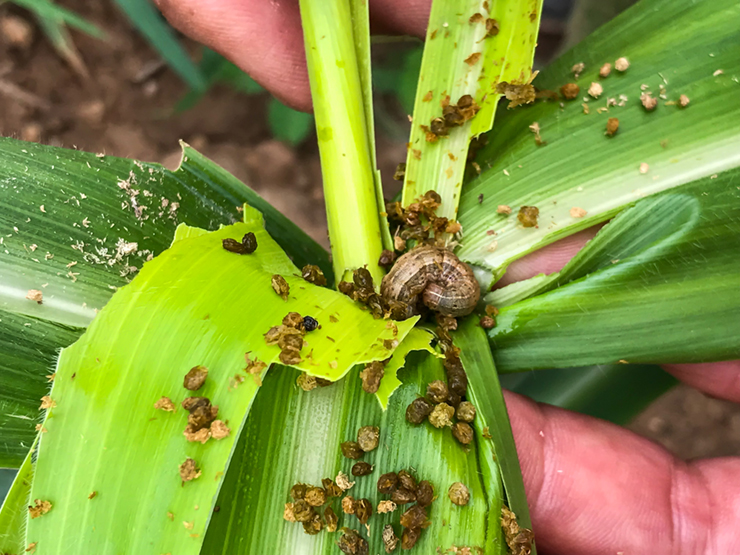Fall armyworm


Red meat producers are advised to be aware and alert for the invasive pest, fall armyworm (Spodoptera frugiperda), which has caused considerable damage to pastures and fodder crops (sorghum, oats, maize) in recent years across the east coast of Australia, particularly Queensland and northern NSW.
Since the pest was first detected in northern Australia in early 2020, key resources have been developed for producers, including information about fall armyworm detections, crop and pasture impacts, current geographic spread, identification tips and management advice.
MLA continues to monitor the situation, including any potential impacts for the livestock sector, whilst keeping industry up to date with the work being led by state and federal governments.
- Commonwealth - Australian Department of Agriculture, Fisheries and Forestry
- Queensland - Department of Primary Industries
- New South Wales - Department of Primary Industries
- Victoria - Agriculture Victoria
- Western Australia - Department of Primary Industries and Regional Development
Below we address some key questions on fall armyworm.
Fall armyworm is an invasive moth, which has been reported to feed on more than 350 plant species, and impacts economically important cultivated grasses such as maize, rice, sorghum, sugarcane and wheat, as well as fruit, vegetable and cotton crops.
Fall armyworm is native to tropical and subtropical regions of the Americas, and since 2016 has spread to Africa, the Indian subcontinent, China and South East Asia.
Adult moths are highly mobile and can fly long distances with suitable weather conditions – hundreds of kilometres on storm fronts. The larvae can also be spread in cut flower, fruit and vegetable consignments.
The number of generations per year varies based on climate, with tropical environments supporting reproduction right throughout the year, while in temperate climates it may only reproduce once per year. When conditions are ideal (summer) the insect can complete a generation within 30 days, with females producing around 1500 eggs during its lifecycle.
The eggs are laid on leaves and larvae emerge within 2-3 days. The larvae then can attack leaves, shoots, stems and fruit. Plants of different ages can be affected, from seedlings to mature plants.
Australia’s climate and the production of suitable hosts are favourable for fall armyworm to establish and spread. Australia’s environment and native flora may also be impacted.
Detailed information on fall armyworm can be found here.
Fall armyworm was first detected on two Torres Strait islands in January 2020. The first mainland detection in Australia was at Bamaga in February 2020.
Subsequent detections of fall armyworm were on a property in the Gulf country of north-western Queensland, and in South Johnstone, Tolga and Lakeland in North Queensland.
Since then, fall armyworm has been detected in New South Wales, Victoria, Tasmania, the Northern Territory and Western Australia.
Fall armyworm is reported to feed on grasses and legume species in grazing systems overseas. It is certain that fall armyworm will be a permanent year-round population in northern Australia and that tropical and subtropical pastures in Queensland and northern NSW are primary hosts. Fall armyworm pressures are likely to be seasonal in temperate regions, only appearing during the warmer months (summer/early autumn) when they migrate from northern Australia to southern NSW, Victoria and Tasmania.
Grasses and legumes that fall armyworm targets include:
|
Species |
Family |
|
Agrostis gigantea (black bent) |
Poaceae |
|
Agrostis stolonifera (creeping bentgrass) |
Poaceae |
|
Avena sativa (oats) |
Poaceae |
|
Avena strigosa (black oat) |
Poaceae |
|
Chloris gayana (Rhodes grass) |
Poaceae |
|
Echinochloa colona (junglerice) |
Poaceae |
|
Eremochloa ophiuroides (centipedegrass) |
Poaceae |
|
Festuca arundinacea (tall fescue) |
Poaceae |
|
Hordeum vulgare (barley) |
Poaceae |
|
Lolium multiflorum (Italian ryegrass) |
Poaceae |
|
Megathyrsus maximus (Guinea grass) |
Poaceae |
|
Miscanthus* giganteus |
Poaceae |
|
Panicum (millets) |
Poaceae |
|
Panicum miliaceum (millet) |
Poaceae |
|
Panicum virgatum |
Poaceae |
|
Paspalum |
Poaceae |
|
Paspalum dilatatum (dallisgrass) |
Poaceae |
|
Paspalum distichum (knotgrass) |
Poaceae |
|
Paspalum fimbriatum |
Poaceae |
|
Paspalum notatum (Bahia grass) |
Poaceae |
|
Paspalum urvillei (Vasey grass) |
Poaceae |
|
Pennisetum clandestinum (Kikuyu grass) |
Poaceae |
|
Pennisetum glaucum (pearl millet) |
Poaceae |
|
Phalaris canariensis (canary grass) |
Poaceae |
|
Phleum pratense (timothy grass) |
Poaceae |
|
Poa annua (annual meadowgrass) |
Poaceae |
|
Poa pratensis (smooth meadow-grass) |
Poaceae |
|
Secale cereale (rye) |
Poaceae |
|
Setaria italica (foxtail millet) |
Poaceae |
|
Setaria parviflora (knotroot foxtail) |
Poaceae |
|
Setaria viridis (green foxtail) |
Poaceae |
|
Sorghum |
Poaceae |
|
Sorghum caffrorum |
Poaceae |
|
Sorghum halepense (Johnson grass) |
Poaceae |
|
Sorghum sudanense (Sudan grass) |
Poaceae |
|
Triticum (wheat) |
Poaceae |
|
Triticum aestivum (wheat) |
Poaceae |
|
Zea mays subsp. mexicana (teosinte) |
Poaceae |
|
Zoysia |
Poaceae |
|
Glycine max (soyabean) |
Fabaceae |
|
Medicago sativa (lucerne) |
Fabaceae |
|
Melilotus albus (honey clover) |
Fabaceae |
|
Trifolium (clovers) |
Fabaceae |
|
Gossypium (cotton) |
Malvaceae |
*https://doi.org/10.1079/cabicompendium.29810
Many of these species are commonly used in pasture systems across tropical, sub-tropical and temperate regions of Australia. Other species listed are used as fodder crops (sorghum, oats, maize) that provide supplemental feed for producers and feedlots – grain, hay, silage.
The potential for fall armyworm to infest other important native and sown pastures is unclear, but it is possible these could be suitable host plants.
Depending on the plant, fall armyworm can cause significant and sudden crop damage, and complete collapse if left unchecked.
Symptoms of fall armyworm include leaf damage such as pinholes, windowing, tattered leaf margins and defoliation of plants.
Producers should also look out for tiny larvae, less than 1mm, that are more active at night, eating pin holes and transparent windows in leaves, and bigger larvae grazing on leaves, stems and fruit, and leaving behind insect excrement.
In species such as maize, sorghum and other grasses, larvae are often in plant whorls where leaves branch from the stalk. A cover of frass (poo) in the whorl can protect the larvae from effective chemical control measures.
Graziers and producers should already have strong on-farm biosecurity measures to protect their crops from pests and diseases.
Crops should be monitored for signs of leaf damage leading to defoliation of the crop and report suspected sightings to assist with early detection, and potential treatment. Infestations often establish after rain when there is fresh pasture growth.
Good farm hygiene should be implemented for weed control to remove hosts that could build populations.
Biological control agents such as predators (birds, ladybugs and nematodes), parasites (wasps and flies) and naturally occurring diseases are important and effective strategies for managing fall armyworm, especially when chemical control is impractical or uneconomical.
Integrated pest management (IPM) approaches are also an option, combining biological controls, insect trapping and chemicals. For more information, contact your local IPM advisor.
Chemical control may be an option for some producers with small land holdings or where infestations are localised on their property. A list of available chemicals can be found on the NSW DPI website or the APVMA permit portal. If chemicals are used it is critically important that label recommendations are followed, including rates, number of sprays and withholding periods. If not, there is a risk to consumers and trade, depending on the chemical. MLA are also in the process of extending labels of certain chemicals to include pastures and fodder species that are without a chemical option.
Anyone who comes across fall armyworm is strongly encouraged to photograph and report suspected sightings to their state department, agronomist, local biosecurity officer or extension officer. Advice on how to manage fall armyworm can also be obtained from these resources, as they will be able to provide recommendations specific to your locality.


